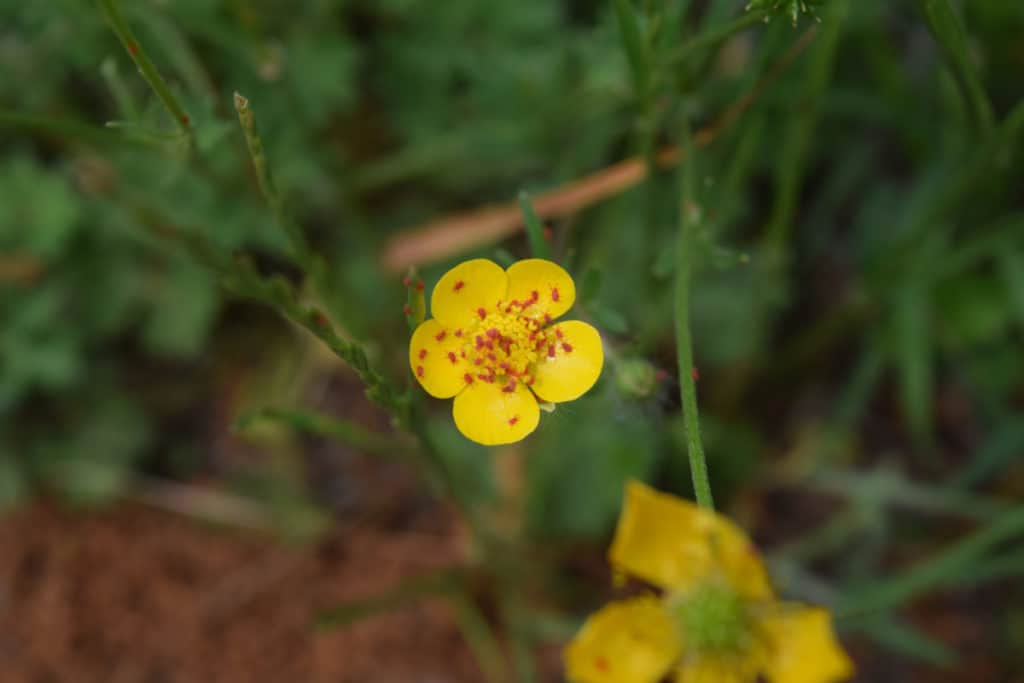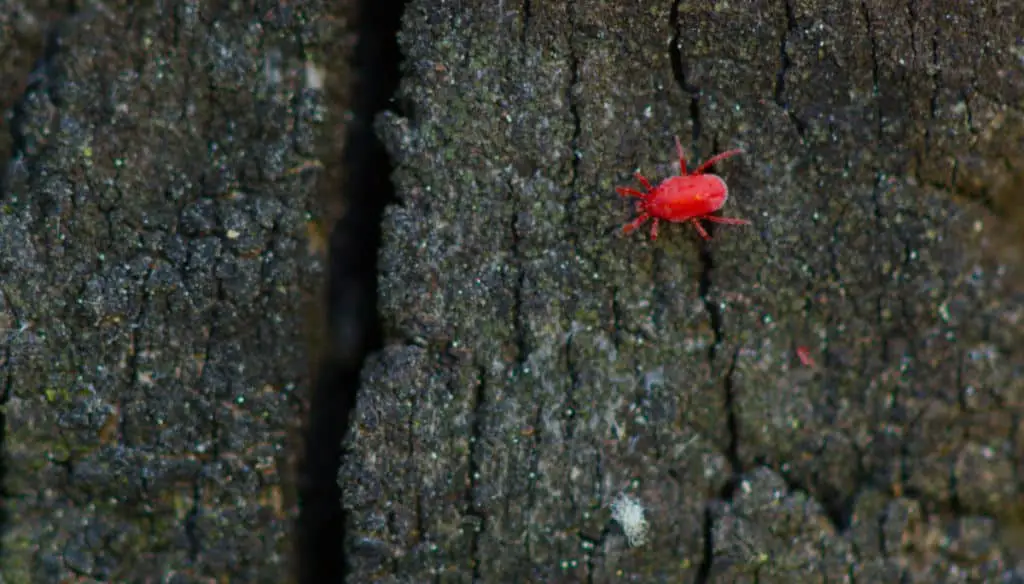While these pesky critters got their name and reputation for munching on clover found on your lawn, as well as other plants, and flowers, don’t be surprised if you see these uninvited guests in your home.
But, why would they come inside? Are they looking for food?
Clover mites are plant feeders that suck the nutritious juice out of lawn grasses, ornamental flowers, clovers, and a wide range of common lawn plants. They don’t bite humans or suck their blood the way other mites do. Your food, furniture, clothing, and pets aren’t their favorites either.
Read on to discover what exactly clover mites eat, how they reproduce, and what to do if you find them in your home.
What Do Clover Mites Eat?
Clover mites feed on a wide range of common lawn plants, such as clover, lawn grasses, ornamental flowers, and dandelion. These greedy mites also eat shepherd’s purse, strawberry, primrose, and daffodil, to name a few.

Lawns with a heavy growth of lush and well-fertilized grass usually attract a large number of clover mites. These tiny creatures don’t say no to plants like Salvia and Alyssum either.
Unlike many mites, clover mites enjoy mostly a vegetarian diet and feed on plants. However, their eating method is the same: they suck the nutrition out of their food.
Their feeding activity causes small, irregular silver streaks on plants, leaves, and flowers, but the damage isn’t apparent initially. It gets more significant as the clover mite population grows. That’s when they can cause extensive damage and turn large areas of lawn brown, yellow, or wilted. Sometimes, homeowners mistake these signs for winter kills, especially on turf.
Besides plants, mold or mildew-infested items are excellent food sources for clover mites when they live on building roofs and patios.
What Do Clover Mites Look Like?
Clover mites are 0.75 to 0.85 mm long arachnids with an oval-shaped body. They come in red or reddish-brown and have eight legs. The front pair is longer than the other six and pointed forward, often mistaken for antennae.

The eggs are bright red and spherical with a diameter of about 0.12 mm. They mostly emerge in late spring, and you can see them with naked eyes.
Clover mites are often misidentified or confused with spider mites and chiggers. If you would like to know more about how to confidently identify clover mites check out these two articles we have written:
Clover Mites Vs Spider Mites: What is the Difference?
Clover Mites Vs Chiggers: Are They The Same Thing?
Clover Mite Lifecycle And Reproduction
Like all mites, clover mites go through four life stages: egg, larva, nymph, and adult.
In their egg stage, clover mites overwinter in any dry, protected area such as sidewalk cracks, walls of buildings, and logs. These locations protect them from scorching summers and freezing winters.
Female clover mites can lay up to 70 eggs, singly or in masses. That’s why their populations can explode once a new generation hatches. They reproduce by parthenogenesis, which means the females can lay eggs without being fertilized by the males.
The eggs hatch in the early spring and mature in around 30 days, depending on their environment.
When the overwintering eggs hatch, they begin to produce a spring generation. This generation will aestivate, a form of summer hibernation wherein mites go inactive on warm, dry days. Second generations typically fully mature in the fall.
The bright red, disk-shaped, and six-legged larvae either move down or drop from the egg site to plants where they begin to feed. Throughout their nymph stage, clover mites are eight-legged like the adults.
One generation usually lasts for a month. Adults live outdoors for about two weeks, as long as the weather condition is suitable for their development.
If plants are dried up or cut off, clover mites start occupying homes and indoors. They start to climb up the walls and find entrances around the windows and doors. Once inside, they look for warm, isolated areas. They stay there as long as the conditions are favorable. If the new location becomes too hot or cold, the mites search for another suitable place.
Clover mites are susceptible to both heat and cold. They die if they’re exposed to temperatures above 39°C. Under temperatures below 24°C, the eggs tend to stop growing. They’re generally active during spring and fall and are usually inactive during summer and winter.
Can Clover Mites Harm Humans And Pets?
As they don’t feed on blood like other species, clover mites aren’t a threat to humans or pets and they don’t transfer diseases either.
While seeing these squatters invading your home can be a pretty disturbing sight, the good news is, even if your house gets infested, your furniture, clothes, and food items will be safe.
Besides their annoying presence, clover mites leave red stains when crushed. These stains are usually confused with blood, but they’re the red pigments from their bodily fluids. Maybe that’s why people think they’re dangerous bloodsuckers while they’re, in fact, harmless.
Clover mites don’t reproduce indoors, and they will die from dehydration in a few days if they can’t find a food source.
If you are interested we have an entire article about this topic. The article is called, Are Clover Mites Harmful?
Signs Of A Clover Mite Infestation
Clover mites often invade residential areas following heavy rain, excessive heat, or a change in seasons. They appear as moving dark spots to the naked eye, crawling around walls, windows, and doors.
The most obvious sign of an infestation is when you see the reddish creatures crawling on surfaces such as windowsills and siding on your home’s sunny side.
How Did I Get Clover Mites?
The most common reason is a well-fertilized lawn. When a significant population of clover mites grows in your lawn, they’ll most likely find their way into your house through the cracks around the windows and doors.
Clover mites don’t fly and since they’re as small as the head of a pin, even the tiniest gap can be an entry. They may also climb home sidings to infiltrate attics and upper levels.
One of the perfect conditions for a clover mite infestation is thick shrubbery around homes. Vast populations of clover mites exist in the spring and early fall when plants are thriving.
Clover mite infestations are more likely on the south and southwestern sides of buildings since the sunlight is milder. They can often be seen crawling on concrete paths in large numbers.
How Do I Get Rid Of Clover Mites?
If you’re dealing with a full-on infestation, it’s best to hire professional exterminators. However, if the situation isn’t serious, you can handle it on your own.
Use a wet sponge or a vacuum cleaner to remove mites, but be careful not to crush them and cause stains. After collecting the mites, destroy the sweeper bag to avoid further problems. You can burn the bag or move it to a safe disposal area away from buildings.
If you spot large populations of clover mites outside your house, remove all the grass and weeds from around the foundation area and create a vegetation-free strip about two feet wide. The plant-free zone will discourage mites from moving into buildings. This technique is essential on the south and southwest sides of the home structure.
Clover mites have a much harder time moving through bare, loose soil than soil-supporting plants stuck to the structure’s foundation. Pea gravel can also hinder their movement.
Tightly seal any holes, cracks, and gaps on the foundations, windows, and doors. The window screens should also fit tightly. This way, even if the mites manage to crawl their way through the soil, they can’t get into your house.
To prevent the infestation in the first place, never over-fertilize the lawn or ornamental plant areas because clover mites develop better in well-fertilized grounds. Next, make sure you don’t have plants that attract mites. These include geranium, chrysanthemum, zinnia, marigold, salvia, rose, and petunia. Shrubs such as barberry, juniper, and yew don’t attract clover mite either.
The Wrap Up
Clover mites feed on various lawn plants such as lawn grasses, clover, and ornamental flowers by sucking their juice. Mold or mildew can also be a food source for clover mites that live indoors.
Their diet consists of plant juice. That’s why they harm your plants and leave silver lines on the leaves and flowers. When they invade an area in large groups, they leave behind dry, yellow, and brown plants.
They’re harmless to people since they don’t suck blood, cause disease, or damaged furniture. If you crush them, they leave red stains because they have red pigments in their bodies.
If you are interested we have a bunch of other articles on the feeding habits of bugs. If you would like, check out some of them below:
What Do Spiders Eat? (Their Fascinating Diets Revealed)
What Do Spider Mites Eat? (They’re Super Bad For Plants)
What Do Praying Mantis Eat? (With Video Hunting A Fish)
Vulture Bees: There Are Meat Eating Bees And They Make Honey
Sources
https://www.orkin.com/other/mites/clover-mites
http://entnemdept.ufl.edu/creatures/orn/mites/clover_mite.htm#life
https://www.pestworld.org/news-hub/pest-articles/clover-mites-flourish-in-early-spring/
https://lancaster.unl.edu/pest/resources/clovermites312.shtml
https://www.cooperpest.com/blog/why-are-clover-mites-in-my-house
